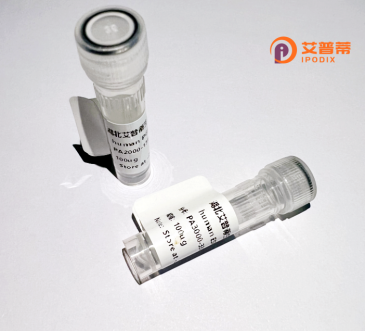
| 纯度 | >90%SDS-PAGE. |
| 种属 | Human |
| 靶点 | ARHGEF3 |
| Uniprot No | Q9NR81 |
| 内毒素 | < 0.01EU/μg |
| 表达宿主 | E.coli |
| 表达区间 | 1-526aa |
| 氨基酸序列 | MVAKDYPFYL TVKRANCSLE LPPASGPAKD AEEPSNKRVK PLSRVTSLAN LIPPVKATPL KRFSQTLQRS ISFRSESRPD ILAPRPWSRN AAPSSTKRRD SKLWSETFDV CVNQMLTSKE IKRQEAIFEL SQGEEDLIED LKLAKKAYHD PMLKLSIMTE QELNQIFGTL DSLIPLHEEL LSQLRDVRKP DGSTEHVGPI LVGWLPCLSS YDSYCSNQVA AKALLDHKKQ DHRVQDFLQR CLESPFSRKL DLWNFLDIPR SRLVKYPLLL REILRHTPND NPDQQHLEEA INIIQGIVAE INTKTGESEC RYYKERLLYL EEGQKDSLID SSRVLCCHGE LKNNRGVKLH VFLFQEVLVI TRAVTHNEQL CYQLYRQPIP VKDLLLEDLQ DGEVRLGGSL RGAFSNNERI KNFFRVSFKN GSQSQTHSLQ ANDTFNKQQW LNCIRQAKET VLCAAGQAGV LDSEGSFLN |
| 分子量 | 59 kDa |
| 蛋白标签 | His tag N-Terminus |
| 缓冲液 | 冻干粉 |
| 稳定性 & 储存条件 | Lyophilized protein should be stored at ≤ -20°C, stable for one year after receipt. Reconstituted protein solution can be stored at 2-8°C for 2-7 days. Aliquots of reconstituted samples are stable at ≤ -20°C for 3 months. |
| 复溶 | Always centrifuge tubes before opening.Do not mix by vortex or pipetting. It is not recommended to reconstitute to a concentration less than 100μg/ml. Dissolve the lyophilized protein in distilled water. Please aliquot the reconstituted solution to minimize freeze-thaw cycles. |
以下是关于ARHGEF3的3篇代表性文献及其摘要概述:
---
1. **"ARHGEF3 regulates skeletal metabolism through RhoA and JNK signaling"**
*Kumamoto et al. (2012)*
研究发现ARHGEF3通过激活RhoA-JNK信号通路,影响成骨细胞分化和骨吸收平衡,其基因多态性与人类骨质疏松症风险相关。
---
2. **"The RhoGEF ARHGEF3 controls cellular senescence via non-canonical Wnt pathways"**
*Hodge et al. (2008)*
揭示ARHGEF3通过非经典Wnt信号(如Wnt5a)调控细胞衰老和细胞骨架重组,提示其在衰老相关疾病中的潜在作用。
---
3. **"ARHGEF3 promotes cancer cell migration by enhancing integrin β1 trafficking"**
*Wang et al. (2019)*
发现ARHGEF3通过调控整合素β1的内吞循环过程,促进肿瘤细胞的迁移和侵袭能力,为癌症转移机制提供了新视角。
---
如需更详细文献信息,建议通过PubMed或Web of Science检索标题与作者获取原文。
ARHGEF3 (Rho Guanine Nucleotide Exchange Factor 3) is a member of the RhoGEF family, which regulates Rho GTPases by catalyzing the exchange of GDP for GTP, thereby activating downstream signaling pathways. Structurally, it contains a Dbl homology (DH) domain essential for its GEF activity and a pleckstrin homology (PH) domain involved in cellular localization. Primarily expressed in osteoblasts, megakaryocytes, and immune cells, ARHGEF3 is implicated in cytoskeletal reorganization, cell adhesion, and motility. Research highlights its role in osteoblast differentiation and bone metabolism, with genetic variants linked to osteoporosis susceptibility. In platelets, ARHGEF3 influences megakaryopoiesis and thrombus formation through RhoA/Rho-kinase signaling. It also modulates immune responses by interacting with integrins and chemokine receptors. Dysregulation of ARHGEF3 has been associated with pathological conditions, including metastatic cancer progression, where it promotes tumor cell invasion via Rho GTPase-mediated cytoskeletal dynamics. Studies in model organisms and human cell lines continue to explore its regulatory mechanisms, emphasizing its potential as a therapeutic target for bone disorders, cardiovascular diseases, and cancer. Despite progress, its tissue-specific functions and interplay with other signaling networks remain areas of active investigation.
×